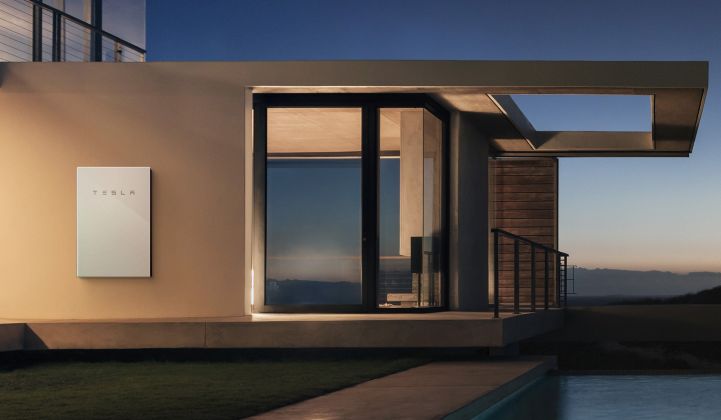If you looked at Tesla's Powerwall website earlier this week you might have noticed that the price for "supporting hardware" had quietly ticked up.
That hardware, known as the Gateway, was previously listed at $700. Recently, it climbed to $1,100.
Today, Tesla followed up with an official global pricing adjustment for the Powerwall, it's famed home energy storage system. In addition to the Gateway increase, the price of the Powerwall itself rose to $6,700 — up $800 from $5,900.
The company already increased the Powerwall price once earlier this year, from $5,500 to $5,900.
“We occasionally adjust our global pricing to best reflect what we’re offering to customers and the value of our products," a Tesla spokesperson wrote in a Friday morning email. "The price adjustments made today are the latest example of that.”
The company touted the Powerwall's "unmatched capabilities" and noted that its batteries, like its electric cars, continually improve over time with new features added via over-the-air updates.
Tesla prices the Powerwall on its website with two units, so that customers can power their homes 100 percent with clean energy and ensure at least 24 hours of power during a utility outage. The recommended system now comes in at $14,500 in equipment costs, plus $1,000 to $3,000 in installation costs, depending on the system complexity.
Tesla has long led the market on battery pricing, which has created something of a problem as demand for the Powerwall has outstripped supply. Even with today's price increase, the 7-kilowatt/13.5-kilowatt-hour Powerwall offers the highest energy density battery for the lowest available price.
But that lead is starting to narrow.

According to the solar marketplace EnergySage, the 9.3-kilowatt-hour LG Chem RESU10H battery is being priced by distributors at $6,000 to $7,000 (LG does not make its U.S. pricing publicly available). That price does not include the battery inverter or the cost of installation. Including the inverter, RESU equipment costs come to between $8,000 and $10,000 — which keeps Tesla in the lead.
New market entrant ElectrIQ recently launched an 11-kilowatt-hour DC-coupled home battery for $8,999, while sonnen recently launched its new premium ecoLinx product in the U.S. with starting price of $26,000.
So the trouble for Tesla isn't really price; it's supply.
CEO Elon Musk noted the company had to shut down a Powerwall cell line in favor of making Model 3 batteries on Tesla's latest earnings call. "But we’re adding new cell lines, and we’ll be able to address that issue very soon," he said.
JB Straubel, Tesla CTO, last month told the SF Chronicle: “The residential market is going crazy, and the demand is more than we can keep up with right now. We’re scaling production as fast as we can, and still there are delays.”
Sources tell GTM that customers have been waiting for around a year to get their hands on a Powerwall, and that these delays can put contracts and access to California incentives at risk. So at some point, price is no longer the most important factor.
Tesla promotes new battery features, next steps
In announcing the global price increase Friday, Tesla highlighted several of the Powerwall’s new and existing features, including its “beautiful” design, ability to work seamlessly with solar panels, and backup power capabilities.
In July, Tesla also added a nifty Storm Watch feature that tracks severe weather. In response, the Powerwall automatically charges to full capacity so the home has a power supply in the event of a utility power outage. The East Coast battery fleet is currently in Storm Watch mode as Hurricane Michael heads north.
Tesla also released smart software in May of this year to minimize peak power usage for customers on a time-of-use plan. Advanced sensors learn the patterns of a customer’s energy usage and signal the Powerwall to use stored energy during peak (i.e., the most expensive) hours.
In addition, Powerwall customers participating in grid services programs can now find out when their battery is benefiting the grid and track the service’s energy and power usage.
As for what’s next, Tesla outlined the following upcoming updates:
- Solution for 3 phase homes in APAC (late 2018-2019)
- Backup functionality in European markets (2019)
- Greater connectivity and boosted reliability (2019)
- Newly designed accessory hardware (2019)
- Full control and management of the Powerwall system through the Tesla mobile app, including the option to switch modes, track self-powering, and view power flow and energy usage in real time (added functionality coming in 2019)
As home battery prices start to come more in line, the question of “value” and battery performance and features will become more important in an increasingly competitive market.
--
Now in its fourth year, GTM's Energy Storage Summit will bring together utilities, financiers, regulators, technology innovators, and storage practitioners for two full days of data-intensive presentations, analyst-led panel sessions with industry leaders, and extensive, high-level networking. This year, we're expanding our traditional U.S. event to cover the global market. Learn more here.




